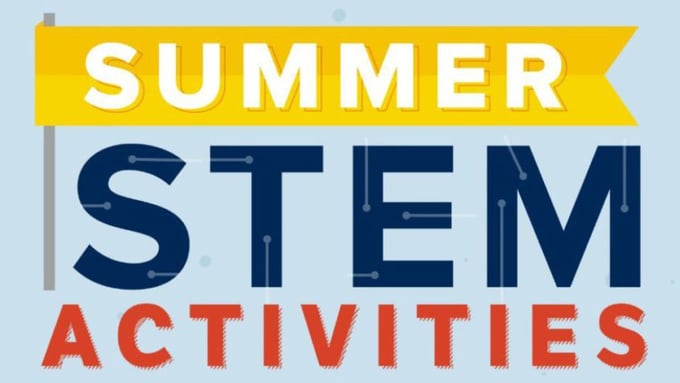Summer will be here before you know it. Summer break is a great time for family vacations, spending time with friends, and relaxing at home, but it is also when many students experience learning loss. We asked the 2018 PLTW Outstanding Teachers to recommend summer activities that students – and their families – can do to keep their brains active and their STEM skills sharp.
Special thanks to the following PLTW teachers who contributed activity suggestions:
- Jeanine Branham Hall, Hendrick Hudson High School in New York, PLTW Biomedical Science
- Maribeth Brown, Kennedy-Powell Elementary School in Texas, PLTW Launch
- Ashley Cosme, Crown Point High School in Indiana, PLTW Biomedical Science
- Cliff Greer, Naples High School in Florida, PLTW Engineering
- Susan Jones, Midway High School in Texas, PLTW Computer Science
- Brett Kisker, Liberty North High School in Missouri, PLTW Engineering
- Mark McAllister, Lafayette High School in Missouri, PLTW Engineering
- Joseline Nacua, Jefferson Elementary School in California, PLTW Launch
- Pamela Rissmann, Dartmouth Middle School in California, PLTW Gateway
- Roy Rosnik, Application Research Lab in Maryland, PLTW Engineering
Which of these activities will you try this summer?
1. Experience Story Time from Space
Listen as real-life astronauts in space read STEM-related children’s books aloud. Story Time from Space’s Library Directory features more than a dozen videos, each featuring a different book. These books include “The Next Time You See a Sunset” written by Emily Morgan and read by Mark Vande Hei, “Moustronaut” written by Mark Kelly and read by Scott Kelly, and “Rosie Revere, Engineer” written by Andrea Beaty and read by Kate Rubins.
2. Create paper mechanisms
Learn how gears and other mechanisms work by creating paper models. You can purchase downloadable paper templates - ranging from a flying pig to a posable paper arm - through robives.com.
3. Learn to code or enhance your programming skills
CodeMonkey uses CoffeeScript, a simplified version of JavaScript, to teach beginner or intermediate users to code. It features great graphics and challenges you to learn all the fundamental concepts of programming.
You can also make games such as Rock Paper Scissors using micro:bit and the MakeCode Editor. These activities require a micro:bit device.
If coding is your passion, add Secret Coders to your summer reading list. This graphic novel series turns logic puzzles and basic programming instruction into a mystery through books for kids ages 8-12. The Secret Coders website also includes coding videos and activities.
4. Make glow-in-the-dark vessels
For this activity, you will need glass bottles or vases of varying shapes, hot water, latex gloves, yellow highlighters, and a black light.
- Fill the bottles or vases with hot water. Experiment with how different amounts of water affect the glow.
- Put on latex gloves, remove the bottom of a yellow highlighter using needle-nose pliers, and remove the felt ink tube from the highlighter.
- Place the ink in one of the bottles or vases.
- Repeat these steps until each vessel has a highlighter ink tube in it.
- Turn on the black light next to the vessels.
- Take notes on the process and record your observations.
5. Create your own app
With MIT App Inventor, a free resource for children and adults, you can use a blocks-based tool to build fully functional apps. You can also find basic tutorials here.
6. Visit a museum
Families across the U.S. can explore their home city, state, or region to discover science and technology museums in their own backyard. If you live in Texas or your summer travels take you to the Lone Star State, visit one of these museums:
- Science Mill (Johnson City)
- Thinkery (Austin)
- Children’s Museum of Houston (Houston)
7. Explore tasty DNA extraction
Visit your local produce stand and then extract fruit DNA at home. Future Learn’s website offers step-by-step instructions on experimenting with DNA extraction from fruit.
8. Engage your imagination through building
You can let your engineering imagination go wild with common items found around the house. Have you ever designed your own amusement park? To begin, brainstorm your park and sketch out your ideas. Bring it to life using household materials like cardboard, plastic straws, rubber bands, and paper towel rolls.
Want to go bigger than an amusement park? Design a tabletop-sized city out of recycled materials. Don't forget to brainstorm on paper first so you don't forget to include essential services!
If you need some building inspiration, check out YouTube videos about how things are built, such as cruise ships and the Panama Canal. (This video explains the history behind the Panama Canal, and this video shows how it works.)
9. Learn computational thinking with Potato Pirates
Gather your family for a fun learning experience. Potato Pirates, a strategy-focused coding card game, teaches “fundamental computational thinking concepts” and is meant for anyone ages 6 and up.
10. Take a nature walk
Nurture your curiosity as you explore your surroundings on a family nature walk. You can observe items that grow naturally and may be surprised to find many things that do not belong in nature, such as plastics that may go into your garbage in one big piece but break down into smaller pieces over time. Write down your observations and think about ways you can recycle at home to protect the environment.


